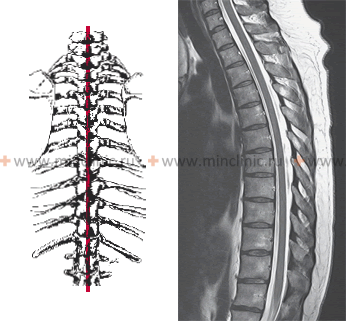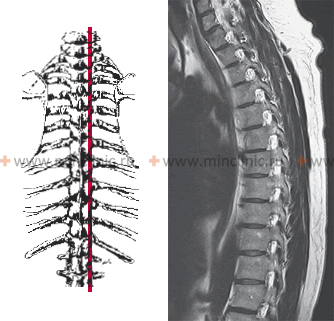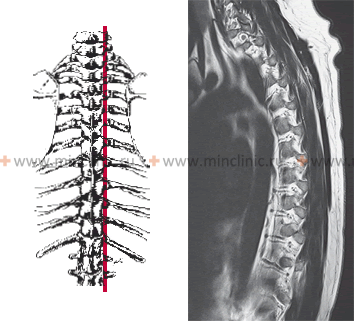Magnetic Resonance Imaging (MRI) of the Thoracic Spine
- Understanding MRI of the Thoracic Spine
- Clinical Indications for Thoracic Spine MRI
- MRI Techniques and Image Reconstruction
- Patient Preparation and Procedure
- Advantages and Limitations of Thoracic Spine MRI
- Comparison with Other Spinal Imaging Modalities
- Role in Diagnosis and Treatment Planning
- References
Understanding Magnetic Resonance Imaging (MRI) of the Thoracic Spine
Magnetic Resonance Imaging (MRI) of the thoracic spine is a sophisticated and highly valuable diagnostic imaging technique that provides detailed cross-sectional images of the thoracic vertebrae (mid-back), intervertebral discs, spinal cord, nerves, and surrounding soft tissues. It is considered one of the most promising and rapidly advancing methods in modern diagnostics for this region of the spine.
Principles and Diagnostic Capabilities
Utilizing strong magnetic fields, radiofrequency pulses, and computer processing, thoracic spine MRI allows physicians to investigate not only structural and pathological changes but also to evaluate certain physicochemical and pathophysiological processes affecting the entire thoracic spine or its individual components. This non-invasive technique offers excellent soft tissue contrast without the use of ionizing radiation (X-rays).
MRI of the thoracic spine can clearly depict:
- Vertebral bodies, posterior elements, and facet joints.
- Intervertebral discs, including their hydration status and potential herniations or protrusions.
- The spinal cord, its size, signal characteristics, and any compression or intrinsic lesions.
- Nerve roots as they exit the spinal canal.
- Paraspinal soft tissues, ligaments, and musculature.
- The epidural space and cerebrospinal fluid (CSF).
Video illustrating the general procedure for a Magnetic Resonance Imaging (MRI) scan of the spine.
Congenital and Acquired Pathologies
Developmental defects of the spine are generally more common in the cervical and lumbosacral regions, but they are not rare in the thoracic spine. In the thoracic region, MRI can identify both congenital malformations and acquired conditions such as traumatic changes affecting the vertebral bodies, intervertebral discs, and the spinal cord itself. For instance, in some congenital anomalies, the thoracic vertebrae may appear as a shapeless bone mass on MRI. Patients with such conditions often exhibit limited mobility in the thoracic region, along with spinal deformities like scoliosis or kyphoscoliosis.
Clinical Indications for Thoracic Spine MRI
An MRI of the thoracic spine may be prescribed by a physician for a variety of reasons, including:
- Osteochondrosis of the thoracic spine: Degenerative changes in the discs and vertebral bodies.
- Intercostal neuralgia: Pain along the intercostal nerves, to investigate potential spinal causes.
- Protrusion and herniated discs of the thoracic spine: Though less common than in the cervical or lumbar regions, thoracic disc herniations can cause significant symptoms.
- Tumors and Metastases: Detection and characterization of primary spinal tumors or metastatic tumor cells at the level of the thoracic spine, including intramedullary (within the cord), intradural-extramedullary (within the dura but outside the cord), or extradural lesions.
- Spinal stenosis: Narrowing of the spinal canal, which can compress the spinal cord or nerve roots.
- Thoracic spine injury: Including fractures, dislocations, or instability of the spine, and assessment of spinal cord injury.
- Anomalies in the development of the thoracic spine: Such as diastematomyelia (split spinal cord), congenital scoliosis, or vertebral segmentation anomalies.
- Inflammatory and Infectious Conditions: Myelitis (inflammation of the spinal cord), discitis (infection of the intervertebral disc), vertebral osteomyelitis (bone infection), epidural abscess.
- Demyelinating Diseases: Such as Multiple Sclerosis (MS) plaques within the thoracic spinal cord.
- Vascular Malformations: Arteriovenous malformations (AVMs) or cavernous malformations affecting the spinal cord or surrounding structures.
- Unexplained Mid-Back Pain or Neurological Symptoms: Such as numbness, weakness, or tingling in the trunk or legs, or bowel/bladder dysfunction.
MRI Techniques and Image Reconstruction
MRI of the thoracic spine allows for the acquisition of a series of thin cross-sectional images in multiple planes (sagittal, axial, coronal). These high-resolution images can be processed to:
- Build Three-Dimensional (3D) Reconstructions: Providing a comprehensive view of the area under study, which is invaluable for understanding complex anatomy or pathology.
- Highlight Vasculature (MRA - Magnetic Resonance Angiography): While not the primary focus of a standard spine MRI, dedicated MRA sequences can visualize blood vessels.
- Visualize Individual Nerve Trunks and Vessels: MRI can show nerve roots and major vessels passing in the projection of the thoracic spine and their relationship to bony and soft tissue structures.
Such detailed reconstructions and multiplanar imaging provide invaluable assistance to spine surgeons and neurosurgeons in planning operations on the thoracic spine and spinal cord, as well as for subsequent postoperative monitoring and control of treatment efficacy. Early diagnosis using MRI for conditions like thoracic osteochondrosis or intercostal neuralgia allows for timely initiation of treatment, potentially improving outcomes and preventing progression.
The ability of MRI to simultaneously demonstrate the spine itself (vertebrae, discs, ligaments) and the surrounding soft tissues (muscles, tendons, spinal cord, nerve roots, epidural fat) over a large area, often without the need for intravenous contrast agents (though contrast is used for specific indications like tumor, infection, or inflammation) and without using ionizing radiation, makes it a superior imaging modality for many thoracic spine conditions. It can effectively determine the localization and size of tumors, assess the cartilaginous surfaces of joints, and evaluate muscle and tendon integrity.
High-field MRI scanners (e.g., 3.0 T) offer enhanced image quality. Intravenous contrast (e.g., gadolinium-based agents like Omniscan) may be used to increase the visual difference between healthy tissue and pathological processes such as tumors or inflammation. Patient weight restrictions (e.g., up to 200 kg) are applicable.
Patient Preparation and Procedure
Preparation for a thoracic spine MRI is generally straightforward:
- Screening: Patients fill out a safety questionnaire to identify any contraindications (e.g., pacemakers, certain metallic implants, claustrophobia).
- Metal Objects: All ferromagnetic metal objects must be removed.
- Clothing: Patients usually change into a hospital gown.
- Fasting: Typically not required for a thoracic spine MRI unless sedation or specific contrast protocols are planned.
- Contrast: If a contrast agent is to be used, an IV line will be inserted. Patients should inform staff of any allergies or kidney problems.
During the procedure, the patient lies on a table that slides into the MRI scanner. A specialized surface coil may be placed on their back over the thoracic region to improve image quality. The patient must remain very still during the scan, which can last from 30 to 60 minutes. Loud knocking sounds are produced by the scanner, and earplugs or headphones are provided.
Advantages and Limitations of Thoracic Spine MRI
Advantages:
- Excellent soft tissue contrast for visualizing spinal cord, nerve roots, intervertebral discs, ligaments, and surrounding soft tissues.
- No ionizing radiation.
- Multiplanar imaging capability without repositioning the patient.
- Can detect conditions not well visualized by X-ray or CT (e.g., early disc degeneration, spinal cord lesions, ligamentous injury).
- Non-invasive assessment of vascular structures with MRA sequences.
Limitations:
- Less sensitive than CT for detecting acute bone fractures or fine bony detail.
- Longer scan times compared to CT, making it more susceptible to motion artifacts.
- Higher cost than X-ray or CT.
- Contraindicated in patients with certain incompatible metallic implants.
- Can be challenging for claustrophobic patients.
- Loud operating environment.
Comparison with Other Spinal Imaging Modalities
| Modality | Principle | Radiation | Primary Strengths for Thoracic Spine | Primary Weaknesses for Thoracic Spine |
|---|---|---|---|---|
| Thoracic Spine MRI | Magnetic fields, radio waves | No | Spinal cord, nerve roots, discs, ligaments, soft tissues, tumors, infection/inflammation. | Longer scan, motion sensitive, less bone detail than CT, cost, MRI contraindications. |
| Thoracic Spine CT Scan | X-rays | Yes | Bone detail (fractures, degenerative bony changes, stenosis), calcified discs/ligaments. Faster than MRI. | Radiation, poorer soft tissue/cord detail than MRI. Iodinated contrast risks. |
| Thoracic Spine X-ray | X-rays | Yes (lower than CT) | Initial assessment of alignment, fractures, gross degenerative changes, scoliosis. Inexpensive, widely available. | Limited soft tissue/cord/disc detail. Superimposition of structures. |
| Myelography / CT Myelography | X-rays with intrathecal contrast | Yes | Detailed visualization of spinal canal, nerve roots, cord compression when MRI is contraindicated or inconclusive. | Invasive (lumbar puncture), contrast risks, radiation (especially CT myelography). Largely replaced by MRI. |
Role in Diagnosis and Treatment Planning
Currently, MRI of the thoracic spine has become a primary diagnostic tool for most diseases affecting this region, often providing more comprehensive information than X-rays or standard CT scans, particularly for soft tissue and neurological pathologies. Its detailed anatomical and pathological insights are crucial for accurate diagnosis, guiding conservative treatment, planning surgical interventions, and monitoring patient progress.
References
- Ross JS, Brant-Zawadzki M, Moore KR, et al. Diagnostic Imaging: Spine. 3rd ed. Amirsys Elsevier; 2015.
- Westbrook C, Roth C, Talbot J. MRI in Practice. 5th ed. Wiley-Blackwell; 2018. Chapter on Spinal Imaging.
- Atlas SW. Magnetic Resonance Imaging of the Brain and Spine. 5th ed. Lippincott Williams & Wilkins; 2016.
- Modic MT, Masaryk TJ, Ross JS. Magnetic resonance imaging of the spine. Radiol Clin North Am. 1989 Jul;27(4):887-901.
- Jinkins JR. MR of the thoracic spine. An update. Magn Reson Imaging Clin N Am. 1993 Feb;1(1):91-106.
- Parizel PM, Van Goethem JW, van den Hauwe L, et al. Current concepts in MR imaging of the pediatric spine. Neuroimaging Clin N Am. 2003 Feb;13(1):105-32.
- American College of Radiology. ACR Appropriateness Criteria® Myelopathy. Last review date: 2021.
- Wilmink JT. CT and MRI of the spine and spinal cord. Saunders Ltd.; 2009.
See also
- Magnetic Resonance Imaging (MRI)
- Magnetic Resonance Angiography (MRA) of the Cerebral Vessels
- Magnetic Resonance Imaging (MRI) of the Abdomen
- Magnetic Resonance Imaging (MRI) of the Brain
- Magnetic Resonance Imaging (MRI) of the Cervical Spine
- Magnetic Resonance Imaging (MRI) of the Hip Joint
- Magnetic Resonance Imaging (MRI) of the Knee Joint
- Magnetic Resonance Imaging (MRI) of the Lumbar Spine
- Magnetic Resonance Imaging (MRI) of the Pelvic Organs
- Magnetic Resonance Imaging (MRI) of the Pituitary Gland (Hypophysis)
- Magnetic Resonance Imaging (MRI) of the Shoulder Joint
- Magnetic Resonance Imaging (MRI) of the Thoracic Cavity Organs
- Magnetic Resonance Imaging (MRI) of the Thoracic Spine
- Magnetic Resonance Imaging (MRI) Study Principle
- Whole-Body Magnetic Resonance Imaging (MRI)






